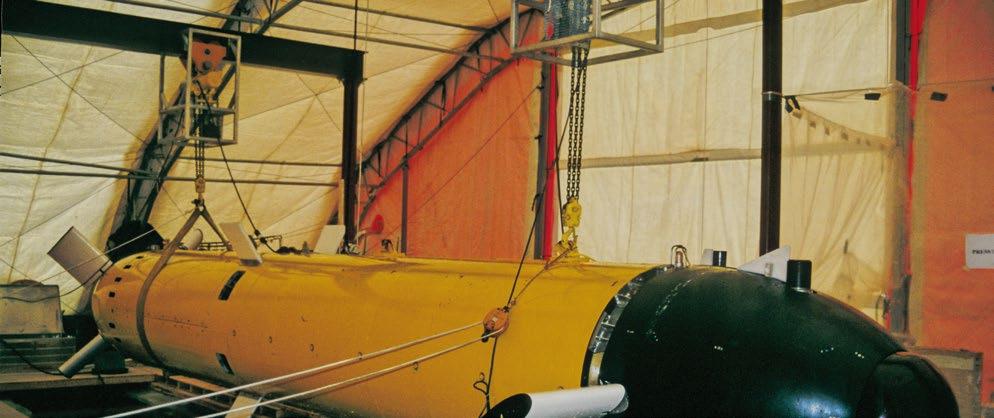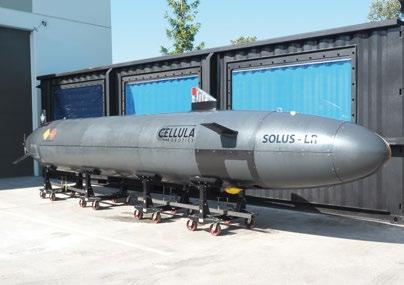
8 minute read
The Theseus AUV: A Cold War Legacy
Theseus suspended above launch ice hole, Ellesmere Island, Canada. 1995. Photo credit: Bruce Butler

Advertisement
by Bruce Butler, P.Eng.
THE COLD WAR
In 1987, the Canadian government released a long-awaited White Paper on Defence, identifying perceived gaps between Canada’s current defence capabilities and its commitments to NATO. Even though the Cold War was waning, Canada was con cerned that in times of conflict, Soviet submarines could use the deep channels of the Canadian Archipelago to reach the North Atlantic.
The Canadian government tasked its Department of National Defence (DND) with determining how to monitor Canada’s Arctic waters for submarine activity. DND initiated a joint Canada-US defence research project, codenamed “Spinnaker,” to install a prototype, seafloor-mounted acoustic listening post on the edge of the Continental Shelf north of Ellesmere Island, Canada’s northern-most point of land. This would require laying nearly two hundred kilometres of fibre-optic cable on the seafloor in waters with a permanent ice cover.
To solve the cable-laying problem, DND scientists assigned to Project Spinnaker consulted Canadian subsea experts. International Submarine Engineering Ltd. (ISE), based in British Columbia, Canada, had recently completed development of the ARCS autonomous underwater vehicle (AUV), built for the Canadian Hydrographic Service for under-ice hydrographic surveying. The DND scientists held several exploratory meetings with ISE engineers, and they soon agreed that a purposebuilt AUV was the best solution.
ARCS AUV outfitted with prototype cable-laying hull section. Photo credit: Bruce Butler


Theseus floating in launch ice hole, Ellesmere Island, Canada. 1995. Photo credit: Bruce Butler

TECHNOLOGY GAPS
To build an AUV that could lay cable while travelling up to two hundred kilometres through frigid waters with unknown bot tom terrain and ice cover then deliver the cable to a precise location, ISE engineers identified several technology gaps: ƀ A navigation system with an en-route accuracy of better than 0.1% of distance travelled, and metre-level accuracy during terminal navigation. ƀ An obstacle avoidance system capable of detecting bottom obstacles and ice keels extending down as far as fifty metres below the surface.
ƀ A high-reliability fault-tolerant computing system that could respond not only to computer hardware and soft ware failures but also to faults in external sensors, actuators, and other onboard systems. ƀ Modular design: the vehicle had to be broken down into components small enough for transport by heavy-lift air craft, helicopters, small fixed-wing planes, and land vehicles. ƀ Launch and recovery: the handling system and vehicle design had to accommodate horizontal deployment and retrieval through a two-metre-thick ice cover. ƀ Automated compensation for a change in buoyancy due to loss of cable.
Theseus being launched on cable-laying mission, Ellesmere Island, Canada. 1996. Photo credit: Bruce Butler
ISE used the ARCS AUV as a technology development plat form to resolve many of these gaps. In the fall of 1990, they held a series of demonstration dives in local BC waters, proving that an AUV could lay cable. The Canadian govern ment gave Project Spinnaker the green light.
MISSION-DRIVEN DESIGN
The new AUV, designated Theseus after the hero from Greek mythology, would be purpose built for laying cable. Theseus was designed using a top-down, mission-driven, systems approach: the vehicle system was decomposed into seven teen subsystems, each with its own mechanical, electrical, and software requirements. Each subsystem was assigned to an ISE engineer who would follow it through the develop ment process, from requirements to design to construction to test. A Systems Engineer ensured all subsystems were harmoniously integrated at each development stage.
During the vehicle design phase, ISE engineers were invited to take part in DND’s annual arctic field trials, codenamed Project Iceshelf. Based out of Canadian Forces Station Alert on the northeastern tip of Ellesmere Island, these trials gave the ISE engineers considerable “on ice” experience and valuable insight into the hostile environment Theseus would operate in.
TESTING
Following a one-year construction period, Theseus underwent two years of testing and local sea trials during which all its subsystems were exercised. Theseus was deployed


nupiri muka AUV preparing to dive under Sørsdal ice shelf, Antarctica, 2019. Photo credit: University of Tasmania Autonomous Maritime Systems Laboratory.

Theseus undergoing sea trials, Indian Arm, BC, 1994. Photo credit: Bruce Butler
to the Arctic in the spring of 1995 for a series of short test dives to validate transportation logistics, key subsystems, and demonstrate cable laying and delivery. In early 1996, Theseus underwent a full-length mission simulation at the Canadian Forces maritime test range near Nanoose Bay, BC. During this fifty-hour mission, it demonstrated acceptable reliability, endurance, and navigational accuracy to confirm it was ready for its full-length arctic cable-laying mission.
THE MISSION
In March 1996, Theseus was disassembled, crated, and loaded into several Canadian Forces C-130 Hercules aircraft for the four thousand-kilometre flight to Canadian Forces Station Alert. It was then transported by helicopter and land vehicles to a near-shore ice camp ten kilometres from Alert, where it was assembled and tested inside a large launch tent.
Just after midnight on April 17, Theseus was lowered horizontally through an ice hole cut through the two-metrethick ice to a launch depth of twenty metres, then released. Twenty-four hours later, after laying over one hundred and eighty kilometres of cable on the seafloor, Theseus arrived at the edge of the Continental Shelf. It ascended and de livered its cable to an ice camp where the American members of Project Spinnaker anxiously waited. The cable was recovered, connected to the just-deployed listening post, and Theseus was commanded to return home.
Explorer AUV docked under-ice for battery recharge and survey data upload, Ellesmere Island, Canada. 2010. Photo credit: ISE

By the time Theseus returned to its launch ice hole thirtyfive hours later, data from the listening post was already streaming back to CFS Alert on the fibre-optic cable. The Spinnaker installation was complete.
THE LEGACY
In 2008, ISE received a contract from the Canadian government to build two AUVs for under-ice surveying. These Explorer-class AUVs resemble a scaled-down version of Theseus and contain state-of-the-art technologies that support a wide variety of customer payloads. In the spring of 2010, an Explorer AUV mapped the seafloor off the western coast of Ellesmere Island in support of Canada’s UNCLOS submission. Over a ten-day period, the vehicle travelled over one thousand kilometres, smashing several of Theseus’s records. In 2011, that AUV performed underice surveys from an icebreaker above 88°N latitude.
ISE has delivered Explorer-class AUVs to several institu tions and governments around the world. In 2017, ISE delivered an AUV, rated to five thousand metres and outfitted for under-ice operation, to the University of Tasmania. The vehicle, named nupiri muka (“eye of the sea” in the language of Tasmanian Aboriginals), performed several test missions in the spring of 2019 under the Sørsdal Glacier near Davis Station, Antarctica. It returned in 2020 and performed several more missions, venturing up to thirty kilometres under-ice while collecting a vast amount of environmental

Solus-LR AUV about to undergo tank testing. Photo credit: Cellula Robotics Ltd.

data, information that will help scientists understand the dynamics of this complex environment and how climate change is affecting the polar regions.
ISE’s autonomous underwater vehicles have reached to wards both poles, establishing ISE, and Canada, as a worldleader in under-ice AUV technologies.
SPIN-OFFS
Most of the ISE engineers and technologists involved in Project Spinnaker have since moved into other fields, some have retired, but a handful still go to work at ISE every day. Two notable alumni have started their own technologybased companies.
Vancouver-based TRAXX Automation, co-founded by ISE engineer Dave Eddy in 2006, provides control system ex pertise in land and marine applications. TRAXX employs over ten engineers, technologists, and software specialists.
ISE engineer Eric Jackson started Vancouver-based Cellula Robotics in 2001, providing automated solutions for subsea geotechnical and geophysical operations. Their first AUV, called Imotus, is a hovering AUV used to perform inspec tions in complex confined spaces. Cellula is currently testing their Solus-LR AUV, powered by a hydrogen/oxygen fuel cell and equipped with a patented suction anchor that allows it to hold station at a surveillance location for up to several months at a time. Cellula employs over twenty en gineers, designers, and technicians.
CONCLUSION
The Cold War is often considered to be a period in modern history that produced terrifying legacies of a chemical, bio logical, and nuclear nature. It did, however, also leave behind many positive ones.
The under-ice voyages of this modern-day Theseus extended Canada’s knowledge not only of the Arctic seafloor, but of the hostile environment above and below the ice pack. The technological seeds planted during Project Spinnaker will continue to bear fruit in the years to come, expanding our limited, but rapidly growing knowledge of the oceans.
Imotus-1 hovering AUV in test tank. Photo credit: Cellula Robotics Ltd.



ABOUT THE AUTHOR Bruce Butler, P.Eng. worked at International Submarine Engineering for fourteen years (1985 to ’97, 1999 to ’01). He was the Theseus Systems Engineer, responsible for the vehicle’s inertial/ acoustic navigation system, and he took part in several arctic field trips, including acting as Chief Pilot during the 1996 cablelaying mission. Want to learn more about Theseus and its Cold War mission? Bruce has written Into the Labyrinth: The Making of a ModernDay Theseus, which is available in print, e-book, and audiobook format. Check out the book here:










